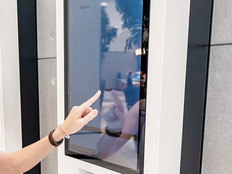Show Me the Pixels
 Over the past few years the LCD monitor has overtaken the bulky and power-guzzling CRT as the display of choice for many business users. Prices have fallen so quickly that even the most basic computers now display crisp, high-resolution images while consuming a minimal amount of desk space. Despite these recent trends, most computers are still not equipped with large-enough screens. If you want to get the most productivity from your average office knowledge worker, bigger is better — and two screens instead of one provide substantial returns.
Over the past few years the LCD monitor has overtaken the bulky and power-guzzling CRT as the display of choice for many business users. Prices have fallen so quickly that even the most basic computers now display crisp, high-resolution images while consuming a minimal amount of desk space. Despite these recent trends, most computers are still not equipped with large-enough screens. If you want to get the most productivity from your average office knowledge worker, bigger is better — and two screens instead of one provide substantial returns.
Technical users and graphic designers have known for years that you can never have enough pixels, the tiny dots on your screen that create the words and pictures you see. A decade ago, computers that could display on two or more monitors became commonplace in technical workstations. Today, most mainstream business computers are capable of powering two monitors, though most users work with only one screen. Many computers are also capable of driving one ultra-high-resolution monitor that can display several windows simultaneously.
Microsoft, Apple and several universities have studied the effects of very large format LCDs and multiple screens. The results are surprising. Apple found that its 30-inch cinema display, delivering more than three times the pixels of a 17-inch LCD, can save an office worker 1.3 hours every week.
The University of Utah performed a similar study this year. In its findings, participants performing common office tasks with two 20-inch LCDs were 44 percent more productive than when they used a single 18-inch LCD.
Michael Lubbehusen, principal of Primary Engineering in Fort Wayne, Ind., equips all nontechnical employees with two 19-inch LCD screens. “This gives all the staff the benefit of keeping e-mail and the phone display up on one screen while working on documents on the other,” he says. “We can have more things on a screen and do side-by-side comparisons.”
Dee Cook, finance manager at Phillips Architecture in Raleigh, N.C., says working with dual monitors is a major advancement. “It felt extravagant at first, but now it is a necessity,” she says. “I’m lost without two. Going home to one screen is like going back to a manual typewriter.”
The energy savings of LCD screens compared with CRT monitors also bring a green element to more screen space. Gary Davis, an IT manager at Heidenhain, in Schaumburg, Ill., has found that many business processes that once required printing can now be done paper-free — greatly reducing costs.
“With one screen the user gets an electronic purchase order from a customer, prints it out, then enters it into our order system and throws the paper away,” he says. “With dual screens they display the P.O. on one screen and the order system on the other.”
Because many business computers are now equipped with dual-monitors or the capability to drive a super-high-resolution LCD, employers can see a benefit right away with minimal extra investment. With 20-inch LCDs selling for less than $250, the ROI for a second screen is typically just a few months. Add in the intangibles of increased staff satisfaction, improved ergonomics and reduced environmental waste, and the investment is quite sound.
Ryan Suydam is the director of operations at DesignFacilitator, a client feedback software company in Raleigh, N.C.






